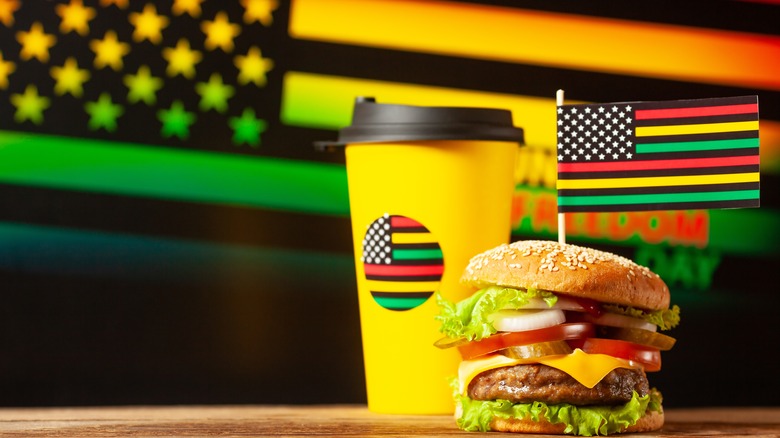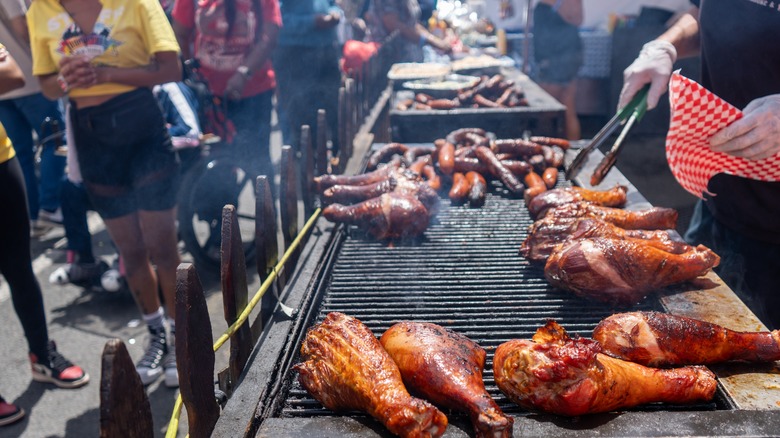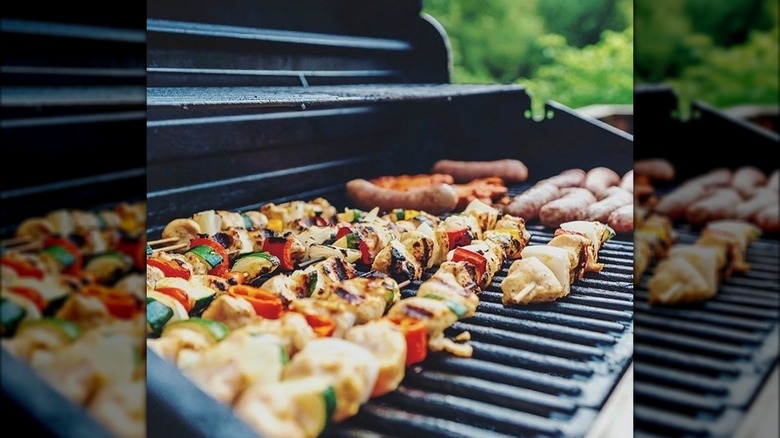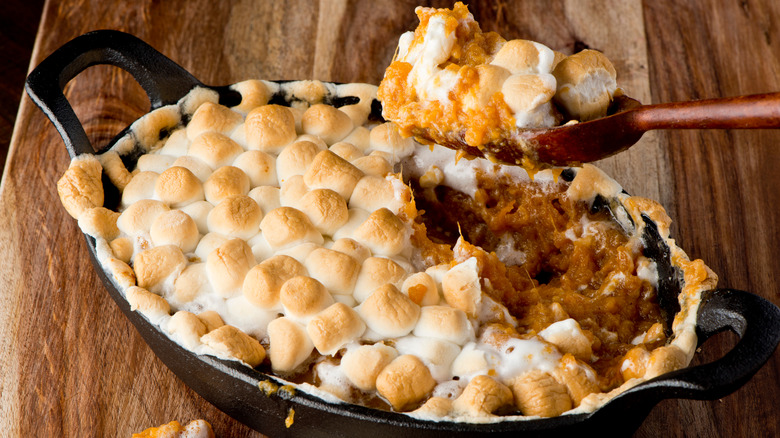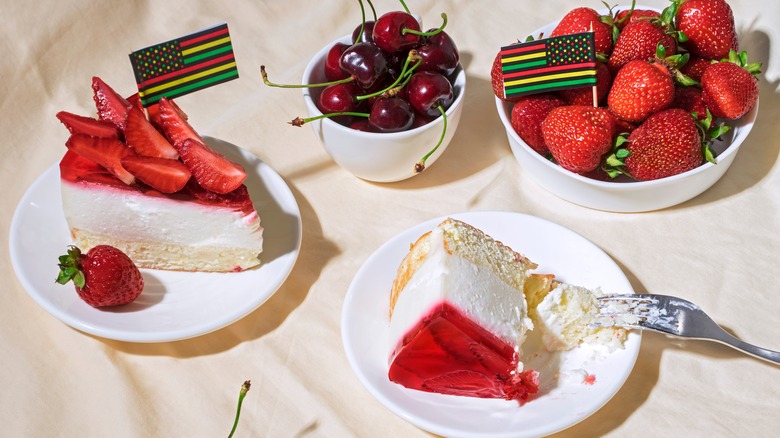The Foods You Should Eat To Celebrate Juneteenth
The symbolism of foods eaten on Juneteenth is a fascinating way of tracing the holiday's origins. You will invariably spot summer cookout dishes like barbecued meats, hamburgers, coleslaw, mac 'n cheese, and Southern staples like cornbread and buttermilk biscuits. Head deeper into soul food territory and dishes with West African influences, like jollof rice are part of the celebrations. And no matter where you are on Juneteenth, red food and drink are ubiquitous. There are multiple regional and historical influences that the foods eaten on America's newest national holiday incorporate, but their core is celebrating African American culture and remembering the complicated history of slavery.
It took two years for news of Abraham Lincoln's Emancipation Proclamation to reach the people of Texas. Juneteenth marks the day in 1865 when, with the arrival of Union soldiers in Galveston, Texas, the last of the enslaved African Americans learned they were free. The first Juneteenth celebrations were held on June 19 the following year in the Lone Star State. Celebrated as a state holiday in several states over the years, Juneteenth, or Emancipation Day, was deemed a national holiday in 2021.
The holiday's Southern origin provides a convenient starting point for understanding which foods to eat on Juneteenth. The dishes are influenced by Southern and soul cuisines and have incorporated regional influences as the holiday became more widely celebrated. However, Juneteenth foods also draw from culinary practices that significantly predate the holiday.
Juneteenth barbecues and mains are iconic
The centerpiece of many Juneteenth celebrations is barbecue — a nod to the holiday's Texan origins. Staples like pork ribs and slow-cooked brisket are popular. However, it isn't the specific dishes cooked on the barbecue but the actual coming together of people around the grill that holds special significance. The communal barbecue is also reminiscent of open-fire cooking that's popular in West Africa for bringing people together over a shared meal.
Many foods eaten on Juneteenth originally came from West Africa, and were commonly eaten in the Mississippi Delta region before and after Emancipation. Jollof rice is arguably the most popular of these dishes, and versions of it can be found all across the country today. Made by cooking rice with tomatoes, onions, spices, vegetables, and meat, the dish's versatility makes it easy to recreate using common ingredients.
You'll find many of the dishes on Juneteenth use inexpensive, easily available ingredients, which is a tradition carried on in diasporic communities, as invention — making delicious food from inexpensive ingredients — characterized the challenge of cooking for oneself as an African American during these times. Cooking techniques were also influenced by domestic service, therefore aspects of French cooking, for example, appear in certain dishes. Keep an eye out for the main of pheasant (sometimes stuffed with jollof rice), which, while today is less familiar in the American diet, was a staple food as hunted game in the 1800s.
Juneteenth starters and sides have symbolic colors
Juneteenth barbecues are accompanied by several sides that most will recognize, especially those familiar with Southern meals. Expect to find mac 'n cheese, deviled eggs, bean and sausage casseroles, and potato salad. Here, the colors of the ingredients used to make the sides often hold significance. In addition, Juneteenth barbecue is accompanied by what are known as prosperity meals, sides made from ingredients like corn and sweet potatoes, which symbolize wealth through their gold color. There will also inevitably be red dishes, like a tomato or watermelon salad (more on that in a moment).
Black-eyed peas and collard greens are essential sides during Juneteenth as well as festivals like Kwanzaa and New Year's because, in addition to signaling good fortune, they also invoke the black and green colors of the pan-African flag. Ingredients like corn, sweet potato, and collard greens hold historical significance beyond their colors,. Since they were economical crops that were easy to grow, harvest, and store, their use was widespread within these communities. Corn was an especially popular crop in the South, and were often a part of the rations afforded to enslaved populations.
Juneteenth desserts have West African influences
While typically eaten as a side, candied yams made from sweet potatoes is a dish that deserves its own course, not just because of its distinct flavor but for the historical significance it holds as an African American food. Dishes such as these stemmed from attempts by early groups of enslaved people to recreate West African flavors using American ingredients. Since American sweet potatoes are not as sweet as African yams, they were cooked with sugar; this may also be why present-day sweet potato casseroles have marshmallow toppings. You'll also find candied yams topped with pecans, marking a Southern influence on the dish.
One dish to look out for is sweet potatoes baked with lemon made using Edna Lewis' enduring recipe that also appears in "The Essential New York Times Cookbook." As a chef and writer, she brought new depth to Southern and soul cooking through her cookbooks and shared accounts of her life in a community of freed slaves. While you have likely unknowingly eaten several dishes inspired by Lewis, one that you are very likely to find for dessert during a Juneteenth celebration is her peach cobbler.
The significance of red foods and drinks on Juneteenth
Red foods are the single most popular category of Juneteenth fare and can be found in every course of the celebratory meal. Popular red foods include red beans, grilled watermelon, strawberry desserts, red velvet cake, and even red barbecue marinades and glazes. The color signifies many things, from celebration to sacrifice, and, appearing on the pan-African flag, which has come to represent both the blood spilled by African Americans fighting for liberation and the shared blood and heritage of all African descendants.
The significance of red in the African American context goes back even further, with historians pointing to the color's importance in Africa. Large numbers of enslaved people belonged to ethnic groups like the Yoruba, Kongo, and Asante, which are spread over present-day Nigeria, Ghana, and surrounding countries. Several of their ancestral beliefs related to power and magic were associated with the color red.
The accompanying red drink is a Freedom Day essential, and present-day iterations include strawberry soda, red lemonade, and Kool-Aid. Records show the presence of a red drink at African American celebrations during and after slavery, and the tradition has endured. The origin may lie in two plant products native to West Africa — the kola nut and the hibiscus flower — both of which are steeped to make an invigorating red tea. Nowadays, there are several ways to color a drink red, but if you're lucky enough to get one with hibiscus, savor it for its flavor and its historic significance.
